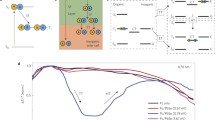Abstract
An increase in the intensity of the exciting light is shown to cause a significant decrease in the quantum yield and rise time of the sensitized phosphorescence of impurity C10H8 and C10D8 in benzophenone crystals. Nonlinear quenching of the impurity phosphorescence occurs because one or two excitations are quenched in the interaction of triplet excitons with impurity molecules in the excited state in which they are left after the first exciton capture. Experiments show the nature of the changes in the quantum yield and the rise time of the impurity phosphorescence as the exciting-light intensity is varied from 3.6 · 1012 to 6 · 1016 photons/cm2 · sec depends strongly on the impurity concentration, the crystal thickness, and the lifetime of the triplet state of the impurity molecules. The experimental results are in good agreement with a proposed theory for the kinetics of the interaction of triplet excitons with impurity molecules in the ground and triplet states.
Similar content being viewed by others
Literature cited
N. A. Tolstoi and A. P. Abramov, Opt. Spektr.,20, 496 (1966).
N. A. Tolstoi and A. P. Abramov, Fiz. Tverd. Tela,9, 340 (1967).
A. S. Gaevskii and A. N. Faidysh, Dokl. Akad. Nauk SSSR,172, 809 (1967).
A. S. Gaevskii and A. N. Faidysh, Dokl. Akad. Nauk URSR, ser. A, No. 1, 44 (1968).
V. G. Roskolod'ko and A. N. Faidysh, Izv. Akad. Nauk SSSR,29, 1309 (1965).
M. D. Galamin, Tr. Fiz. In-ta Akad. Nauk SSSR,12, 3 (1960).
A. S. Gaevskii, V. G. Roskolod'ko, and A. N. Faidysh, Opt. Spektr.,22, 232 (1967).
J. Jortner, S. A. Rice, J. L. Katz, and S. Choi, J. Chem. Phys.,42, 309 (1965).
R. G. Kepler and A. C. Switendick, Phys. Rev. Letters,15, 56 (1956).
M. Levine, J. Jortner, and A. Szoke, J. Chem. Phys.,45, 15 (1966).
R. Voltz, H. Dupont, and T. A. King, Nature,211, No. 5047, 405 (1966).
E. L. Frankevich and B. M. Rumyantsev, Zh. Éksp. Teor. Fiz.,53, 1942 (1967).
V. M. Korsunskii and A. N. Faidysh, in: Optics and Spectroscopy [in Russian], No. 1 (1963), p. 119.
Author information
Authors and Affiliations
Additional information
Translated from Izvestiya Vysshikh Uchebnykh Zavedenii Fizika, No. 8, pp. 12–16, August, 1969.
Rights and permissions
About this article
Cite this article
Gaevskii, A.S., Priimachek, V.R. & Faidysh, A.N. Interaction of triplet excitons with excited naphthalene and deuteronaphthalene molecules in benzophenone crystals. Soviet Physics Journal 12, 983–986 (1969). https://doi.org/10.1007/BF00820925
Received:
Issue Date:
DOI: https://doi.org/10.1007/BF00820925




